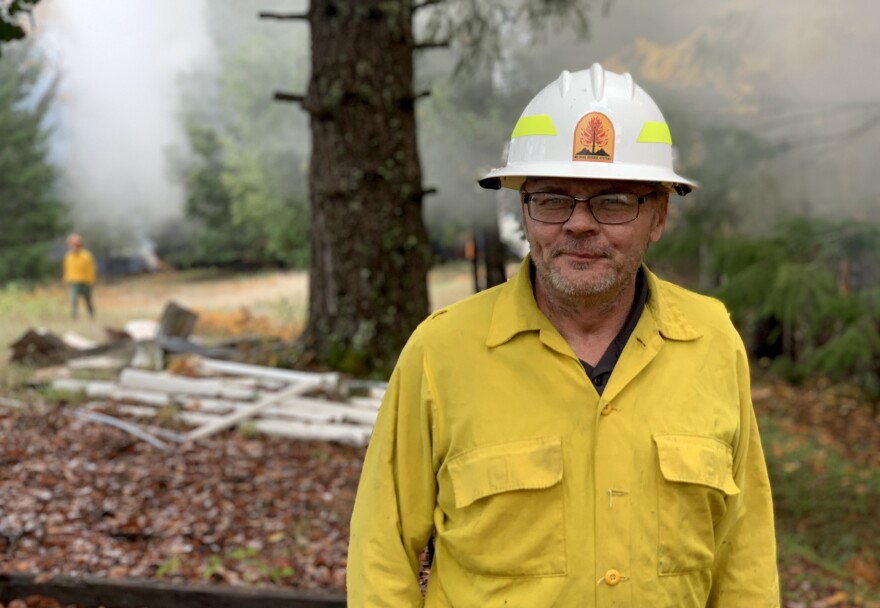Outside the tiny town of Orleans, on a hillside of fir, madrone and maple trees, Jess McLaughlin pokes the end of a metal drip torch, a sort of oversized metal watering can with a flaming spout, into a five-foot-high pile of brush and logs.
“We’re putting drip-mix fuel on this one,” he says. “This one’s three parts diesel, one part gas.”
McLoughlin works for the Mid Klamath Watershed Council, a local group helping host this TREX event, also known as a prescribed fire “training exchange.”
Nearby, volunteer Heron Brae from Eugene, Oregon is doing the same thing. But the wet weather is not making it easy.
“It feels really, really soggy right now. And I’m kind of new here and I’m just giving myself a pep talk like ‘It’s not me, it’s the fuel moisture. It’s not me,’” she laughs.
Around 20 volunteers and staff are lighting these piles of wood on fire. Soon, it looks like a dozen bonfires burning in every direction.

Five acres are being burned today on this 50-acre homestead near the Klamath River. This summer, the owners came close to defending it from the 95,000-acre McCash fire. It stopped burning one mile away, according to residents.
The fires will help remove vegetation and create defensible space around the property in case of a future wildfire.
Another volunteer, Annie Leverich, wears what looks like a jet pack but is, in fact, a large propane tank with shoulder straps and a handheld torch.
“I’m going to take the tip of the torch here and kind of put it strategically towards the bottom of the pile where I can see some fuel,” she says, as a woosh of blue-burning gas sends sparks into the pile.

The point of all this is to normalize fire and give people who don’t work at fire agencies experience doing prescribed burns.
The participants stand in a circle while Scot Steinbring, the “burn boss” for the day, pairs them up by skill level.
“Spend time teaching and training. How many qualifies do I have?” he says, asking about the experience of participants. “Alright, so what I would like you to do is find a trainee and adopt a trainee for the day.”
TREX events are an example of how perspectives about fire are changing from that of excluding all wildland fires to seeing natural and prescribed fire as a critical management tool.
“Smokey Bear did a really great job for many years teaching fire was bad,” Steinbring says. “And now that we’ve gotten into a new culture where we need to understand and teach that fire and smoke, in the right atmosphere and training opportunities, is going to reduce the large fire.”

Protecting communities from wildfires is a major concern here. In 2020 the Slater Fire burned almost 160,000 acres nearby including communities in the town of Happy Camp.
Kathy McCovey, an archeologist, fire fighter and member of the Karuk tribe, was in that fire. She stands where her house used to be in a valley along Indian Creek before it burned.
“As you can see, as we’re looking up on the landscape, there’s a lot of burned trees for miles and miles,” she says, staring up at the torched hillsides.
Support from the Karuk tribe is one reason the Klamath TREX event is the largest program of its kind in the country. The Karuk tribe have been using fire for millennia for what they call cultural burning.
“The tribal people along the Klamath River, the Karuk, use fire to dictate what types of plants we grow there, what species, how they grow, when they grow. They were managed with fire,” McCovey says.

Cultural burning helps influence the growth of plants they use, like mock orange for arrow shafts, and hazel sticks and bear grass used to weave baskets, she says.
“This is really traditional ecological knowledge that we’ve been passed down, that we still utilize, we value,” she says. “It’s unique; indigenous to this place.”
Two new laws were passed in California this year to increase cultural burning and prescribed fires.
One will create a process for tribal members to count their cultural burning experience towards becoming a certified burn boss. More often that experience is accumulated while working for federal agencies.
The second law focuses on reducing the liability standard for prescribed fires in case of an accident.
Both cultural fire and prescribed burning have a long history, according to Lenya Quinn-Davidson, the director of the Northern California Prescribed Fire Council.
“We need to remember the roots of prescribed fire are in the hands of average people who are managing their landscape,” she says, “and there’s a strong connection there between people and fire as a tool.”
With every catastrophic wildfire season, she says, the popularity of TREX goes up as more people find themselves wanting to create a positive relationship with fire.



